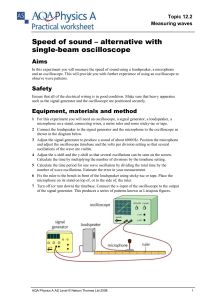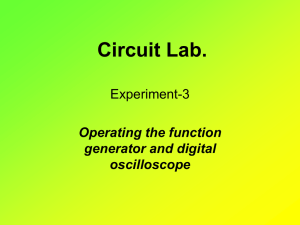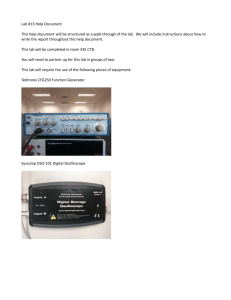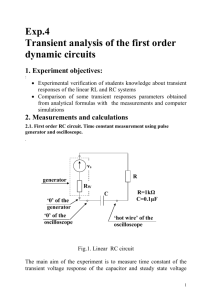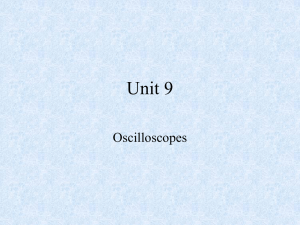AQA AS level Physics A
advertisement
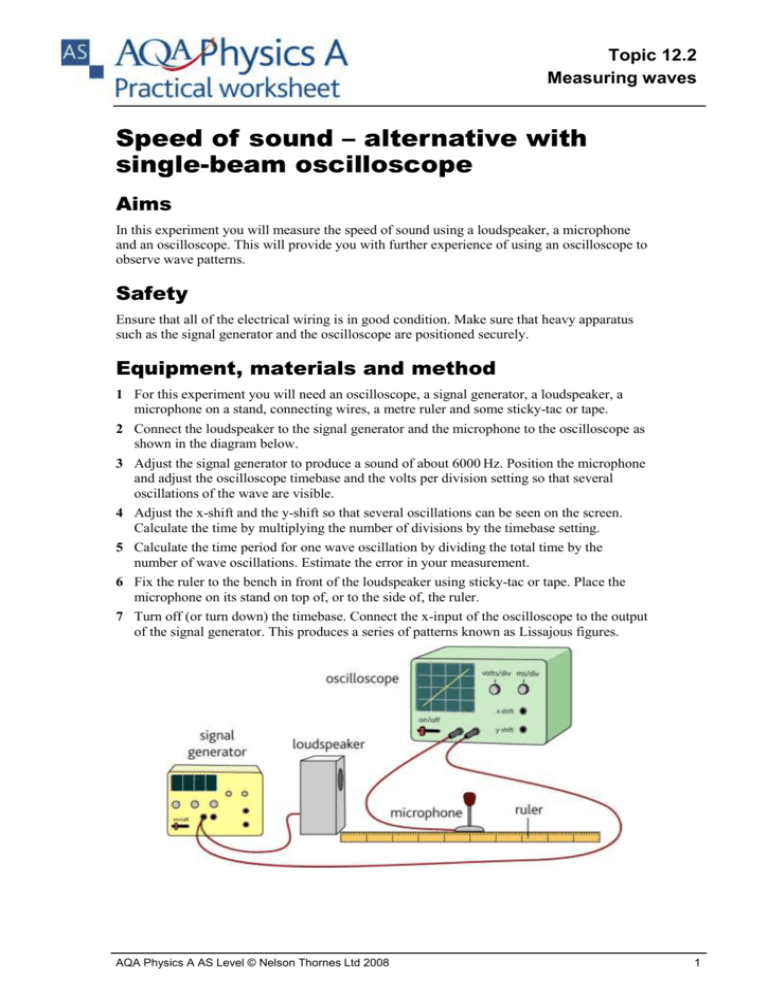
Topic 12.2 Measuring waves Speed of sound – alternative with single-beam oscilloscope Aims In this experiment you will measure the speed of sound using a loudspeaker, a microphone and an oscilloscope. This will provide you with further experience of using an oscilloscope to observe wave patterns. Safety Ensure that all of the electrical wiring is in good condition. Make sure that heavy apparatus such as the signal generator and the oscilloscope are positioned securely. Equipment, materials and method 1 For this experiment you will need an oscilloscope, a signal generator, a loudspeaker, a microphone on a stand, connecting wires, a metre ruler and some sticky-tac or tape. 2 Connect the loudspeaker to the signal generator and the microphone to the oscilloscope as shown in the diagram below. 3 Adjust the signal generator to produce a sound of about 6000 Hz. Position the microphone and adjust the oscilloscope timebase and the volts per division setting so that several oscillations of the wave are visible. 4 Adjust the x-shift and the y-shift so that several oscillations can be seen on the screen. Calculate the time by multiplying the number of divisions by the timebase setting. 5 Calculate the time period for one wave oscillation by dividing the total time by the number of wave oscillations. Estimate the error in your measurement. 6 Fix the ruler to the bench in front of the loudspeaker using sticky-tac or tape. Place the microphone on its stand on top of, or to the side of, the ruler. 7 Turn off (or turn down) the timebase. Connect the x-input of the oscilloscope to the output of the signal generator. This produces a series of patterns known as Lissajous figures. AQA Physics A AS Level © Nelson Thornes Ltd 2008 1 Topic 12.2 Measuring waves 8 The Lissajous figures show the phase difference of the two signals. For two signals of the same frequency the following figures are obtained: Signals in phase Phase difference of 90° Phase difference of 180° (π) 3 Phase difference of 270° 2 2 9 Adjust the microphone position along the ruler until the two waves on the screen are exactly in phase so they form a line of positive gradient. Record the position of the microphone. 10 Move the microphone exactly one wavelength along the ruler. Watch what happens to the trace. When the two waves are in phase again you have moved through one wavelength. Continue to move the microphone as many complete wavelengths as possible. You may need to adjust the gain on the scope almost constantly as the microphone moves away. Measure the total distance moved and record the total number of wavelengths. Estimate the error in your measurement. Question Use your error estimates to calculate the percentage error in the values of frequency and wavelength you obtained and hence find the percentage error in your value of the speed of sound. Results 1 Calculate the frequency of the wave given that: frequency = 1 time period 2 Is your answer similar to the signal generator setting? If not, explain why. 3 Calculate the wavelength of the wave by dividing the distance moved by the number of wavelengths. 4 Calculate the velocity of the sound wave where velocity = frequency × wavelength AQA Physics A AS Level © Nelson Thornes Ltd 2008 2 Topic 12.2 Measuring waves Discussion The speed of sound increases if the temperature of the air increases. How do you think an increase of the air temperature would affect your measurements? AQA Physics A AS Level © Nelson Thornes Ltd 2008 3 Topic 12.2 Measuring waves Teaching Notes Aims To measure the speed of sound in air using a loudspeaker, a microphone and an oscilloscope. To take measurements from an oscilloscope and calculate values of wave period according to the oscilloscope settings. Safety All electrical wiring should be checked. Make sure that heavy apparatus such as the signal generator and the oscilloscope are safely positioned on the benches. Some apparatus may be too heavy for some students to lift. Teaching notes 11 This experiment should take about 25 minutes. 12 Depending on the availability of oscilloscopes, microphones and signal generators, it may not be possible to carry out a class practical individually or in pairs. 13 Check the settings of the oscilloscope for a visible trace from the microphone and the signal generator prior to the lesson. If no trace can be seen, try connecting the input switch to ground initially. Adjust the x-shift and y-shift. Then adjust the timebase and volts per division to obtain a suitable trace. 14 The trigger input ‘locks’ the timebase oscillator from the input voltage. This allows a stationary trace to be viewed. As the microphone is moved it is easier to link the change in phase relationship to this stationary image from the signal generator. 15 Note that the signal generator should be the trigger input. 16 For a single-beam oscilloscope the signal generator should be connected to the x-input and the microphone to the y-input. Answer to question The students should be able to find the speed of sound in air to within 5–10%. They will need to be told that the percentage uncertainty in the speed of sound is equal to the sum of the percentage uncertainties in the measurement of frequency and wavelength. Note that measuring more than one wavelength minimises the uncertainty in the measurement. For example, measuring two wavelengths halves the measurement uncertainty and measuring three reduces it to a third. Discussion The frequency will be unchanged so the waves on the screen will have the same spacing. The wavelength will be longer so the distance between successive ‘in-phase’ positions will be greater. AQA Physics A AS Level © Nelson Thornes Ltd 2008 4 Topic 12.2 Measuring waves Practical assessment opportunities 1 PSA – Selecting and using equipment: 0–3 marks (Following instructions and group work; organisation and safety assessed at end of course.) 2 ISA preparation: practical task – practice in making precise and reliable measurements, carrying out calculations and estimating errors written task Section B – opportunities to analyse data and errors and use the results to draw conclusions and to evaluate the strength of the conclusion Tech Notes Equipment and materials required Each student or group of students will require the following equipment: some sticky-tac or tape a dual-beam oscilloscope (or a single-beam oscilloscope with an x-input) a signal generator a loudspeaker a microphone on a stand connecting wires a metre ruler Safety Check all electrical wiring. Make sure that heavy apparatus such as the signal generator and the oscilloscope are safely positioned on the benches. Some apparatus may be too heavy for some students to lift. AQA Physics A AS Level © Nelson Thornes Ltd 2008 5
